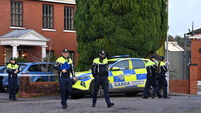Clodagh Finn: The Kerry aristocrats who deserve a series on Netflix

Fact, they say, is infinitely more enthralling than fiction and here is proof of it in the story of the last earl of Kerry who, from 1789, continued to entertain at his opulent townhouse on the Champs Élysées in Paris, oblivious to the French revolution that was gathering pace all around him.
Francis Fitzmaurice, third earl of Kerry, and his wife, Anastasia Daly, a Catholic divorcee 20 years his senior (a scandal in itself) went on living as they had always done, printing as many as 500 invitations to their lavish soirées and ordering the very best of food.
Whet your appetite on this sample from the caterers’ menu: smoked salmon from the Atlantic, olives, oysters, pâtés and terrines, smoked beef, pork, sausages, ham, lobster, several types of cheeses, gateaux, the best of wines, champagne and Cognac.
The earl used the “suppliers to the King” — Louis XVI, the man who would soon lose his head — to buy his tailored clothes, wigs, opera glasses and spectacles. Lady Kerry, meanwhile, frequented Marie Antoinette’s preferred designer and hatmaker, and was fond of perfume, lingerie and expensive jewels.
If you were to make it up, you might draw the line at the couple’s daily jaunts around revolutionary Paris in their luxurious four-wheeled carriage, which was emblazoned with the Kerry coat of arms and attended by liveried coachmen with powdered wigs.
The common people in Paris could not afford to buy bread while, back in north Kerry, the tenants on the earl’s once-large estate of 90,000 acres were living in cabins, eking out a miserable living to pay rents that did not even come close to funding Lord and Lady Kerry’s extravagant lifestyle.
Despite mounting debts, the spending continued and, by 1818, Francis Fitzmaurice had squandered his family’s titles, estates, wealth and lands, putting an end to a dynasty that had been Kerry’s most powerful family since their arrival in the county in the 13th century.
The story is told in fascinating and vivid detail by historian and genealogist Kay Caball in her new book, .
Indeed, this reader has spent the last number of weeks imagining how to bring this story of power, prestige, immense wealth and, of course, scandal to the screen.
If the Regency period-drama , which takes place a little later, can attract some 63m viewers, I reckon the real-life story of the demise of the House of Fitzmaurice has, at the very least, a good chance of interesting a new generation in the vapour-inducing behaviour of Kerry’s upper crust.
The scandals exposed in Lady Whistledown’s society gossip sheet in , for instance, are trifling when compared to the salacious details that emerged during the divorce action taken by Anastasia’s husband, Charles Daly, against the Earl of Kerry for "criminal conversation" — a euphemism for adultery — with his wife.
In one particularly racy testimony, the earl’s housemaid, Bridget How, said she was busy making up the fire, but hid behind a screen when she heard the couple approaching. Servants were not supposed to be in the room after 11 o’clock. Bridget went on to describe how the earl bolted the door before kissing and toying with Anastasia. There was mention of petticoats and more besides, before Anastasia went to the mirror afterwards to “set her caps to rights”.
But before the post-watershed scenes in our imagined series, we might flash back to the early meetings of Francis Fitzmaurice and Anastasia Daly of Galway, which took place in a glittering social scene in Dublin around 1763. He was a 23-year-old sought-after wealthy aristocrat enjoying all that the Georgian city had to offer — concerts, theatre, balls, dinner parties and gambling. She was a married Catholic about 20 years his senior.
Nonetheless, Francis paid her great attention and, as the court later heard, “was observed to be always near her at public places”.
In these travel-restricted times, it is fascinating, too, to imagine the couple’s stomping ground. Francis had a lavish house on Molesworth Street in Dublin, not far from Kildare House (now Dáil Éireann), the exquisite home of the Duke of Leinster.
Further down the road, Francis’s cousin (and future prime minister of Great Britain from 1782-83) Lord Shelburne, William Fitzmaurice-Petty, had a house roughly where the Shelbourne Hotel is now. Indeed, that is where the hotel got its name.
The great and the good would have strolled daily around St Stephen’s Green, taking the air, showing off their new clothes and exchanging gossip, as historian Kay Caball puts it.
And what gossip was to come. On 6 May 1764, Anastasia Daly made her escape on horseback from her marital home in Loughrea, where she and her maid had been confined to the house and courtyard by her husband, Charles Daly.
She had secretly sent letters, via a shoemaker in the town, to Francis in Dublin and her sister, who later wrote that Anastasia would “sooner die on the road than risk to fall into the hands of her tyrant [husband] again”.
Caball offers us this evocative description:
What a wonderfully cinematic vignette of a real episode in the life of an 18th-century Irish woman whose own personal income of £500 a year (some €97,000 today) gave her a degree of independence that was unusual at the time.
She left without her jewellery and later unsuccessfully sued her husband to return, among other items, her brilliant diamond hat pin, large sapphire ring set with diamonds, gold thimble, mother of pearl fan inlaid with gold and a pair of French shoe buckles.
That is only the start of the drama, which played out among the rarefied salons of Bath, London and Paris over a number of years, while Francis Fitzmaurice squeezed every last penny out of his estate and left the family’s once-magnificent court at Lixnaw in Co Kerry to fall to ruin.
Francis eventually sold his estate to Cork merchant Richard Hare and persuaded him not alone to part with £13,000 (€2.5m today) for the land, but to agree to pay him a yearly annuity of £3,000 for his lifetime and £2,000 a year to Anastasia if he died before her.
And that is only one sliver of the story. In future episodes, expect political rivalries, numerous court cases, a child outside wedlock, the earl’s servants facing the guillotine in Paris and, most impressively, the story of the Listowel woman who has woven it all together, historian Kay Caball, herself a descendant of the Kerry tenants who paid so heavily for their landlords’ feckless lifestyles.
The Fitzmaurices, the Netflix series, looks set to run and run.












